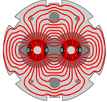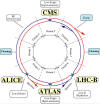
LHC Machine Outreach
Frequently Asked Questions
 |
LHC Machine Outreach Frequently Asked Questions |
 |
|
See also the CERN compilation of frequently asked questions. What need is there for such large dimensions of
your particle accelerator as you cannot accelerate particles beyond
speed of light?
IS IT SAFE? Hawking says, "there might be primordial black holes with a very much smaller mass that were made by the collapse of irregularities in the very early stages of the universe. Such black holes would have a much higher temperature and would be emitting radiation at a much greater rate." Why does this not apply to the LHC? Two main reasons: 1. Theory - Hawking himself recognized that black holes radiate. Given the energy available in the LHC, if a black hole was created it would necessarily be a very small one - a micro black hole - the energy available in the collision of two LHC protons is not a lot on a cosmological scale. The black hole would evaporate almost immediately into a shower of particles. 2. Cosmic rays - Extremely high energy particles (orders of magnitude above the LHC) coming from outer space are incident on upper atmosphere where they collide with the nuclei of gas molecules. We see the showers resulting from these collisions at sea level. This is appears to be safe, so we can be confident that the LHC will be. How much do the protons weigh in the LHC at 7Tev? The energy of a proton is 7 TeV. Via E = mc2 the mass is simply 7 TeV/c2 - and these are the units usually used. 7 TeV/c2 divided by the rest mass .938272029 GeV/c2 gives us 7460.52 times the rest mass Working in SI units we can do the same thing more explicitly: At 7 TeV:
m/mp = 7460.52 as before This number is gamma i.e. 1/square root( 1- v2/c2) - from which you can easily calculate the velocity. COST? The cost of the accelerator only (without experiments and computing) but including manpower and material is 4.7 Billion CHF (that's around 3.03 billion euros) Is there a mechanism at CERN that would prevent the LHC from even turning on if someone was in the tunnel, making the chances of that effectively impossible? (For example, someone at Brookhaven National Laboratory told me that once they're tunnel is locked down it's only accessible by a key, and that key is also required to start the machine.) You mentioned that the radiation levels in the tunnel away from experiments would be 10 Gray per year. Any idea as to what the level would be NEAR the experiments, or in the event of a beam loss, or directly in-contact with the beam? How long does it take for a proton to go from zero to 14 TeV ? When a proton leaves the source, it crosses the linac and reaches the PSB in a few microseconds. In the PSB it is accelerated from 50 MeV to 1.4 GeV in 530 ms, Multiply by the speed of light to get the distance traveled!
|